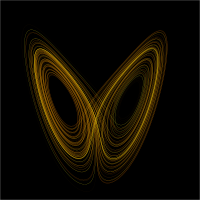
Photo from wikipedia
We attempted to create a mathematical model for neuronal differentiation. The present study was performed within the framework of self-organization with constraints by looking for an optimized informational unit. We… Click to show full abstract
We attempted to create a mathematical model for neuronal differentiation. The present study was performed within the framework of self-organization with constraints by looking for an optimized informational unit. We treated networks of individual dynamical system units with an external input, which was provided by coupled one-dimensional maps with possible forms of unidirectionally feed-forward network, random network, small-world network, and fully-connected network. We used a genetic algorithm to maximize the information transmission for each type of network. Optimized maps were obtained depending on the coupling strength and network structure. These maps can be classified into three types: passive, excitable, and oscillatory. In particular, the excitable and oscillatory types of dynamical systems possess characteristics that are quite similar to those of neurons, whereas the passive and oscillatory types of dynamical system may represent glial cells.
Journal Title: Neuroscience Research
Year Published: 2020
Link to full text (if available)
Share on Social Media: Sign Up to like & get
recommendations!